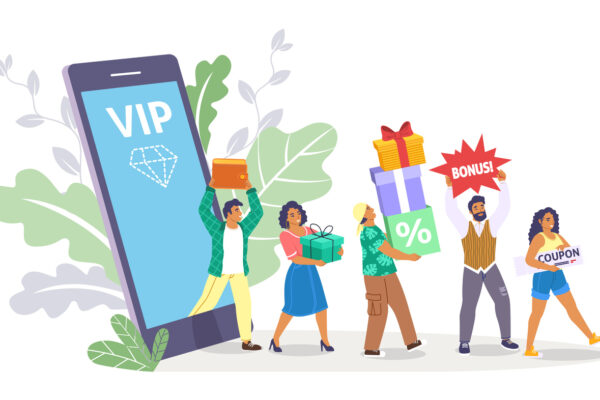It’s a competitive landscape out there in the ecommerce retail world. As more and more businesses focus on online expansion, from established brick-and-mortar stores to new online-only retailers, the options available to customers keeps increasing. This can make it difficult for ecommerce merchants to gain and keep customers. According to the Salesforce Connected Shoppers Report, the number one retail industry challenge is increased competition.
Customer loyalty also isn’t what it used to be; Coveo’s Ecommerce Relevance Report 2023 shows that 60% of customers are more likely to shop at more affordable stores, compared to only 17% who are brand loyal to specific merchants and brands, even if they cost more. This is undoubtedly a result of the tight pandemic years, as well as post-pandemic economic uncertainty and inflation. Customers are more concerned than ever about making their dollars stretch.
Luckily, there’s a solution that benefits both merchants and customers: loyalty programs.
Benefits of a Loyalty Program
Loyalty programs are a great way for customers to get more bang for their buck, and they’re a great way for merchants to increase sales without increasing their advertising budgets. Salesforce reports that 58% of shoppers are more likely to purchase from a store if they belong to that store’s loyalty program.
And there are other benefits, as well: customers who belong to loyalty programs are more likely to be engaged – both with your business and with others about your business. When customers engage with your business, they feel more appreciated, so they’ll frequently turn that appreciation outward: bragging about it to their friends or sharing their good deals with followers on social media.
This free advertising means those friends and followers in turn are more likely to become customers and sign-up for the loyalty program – and the cycle continues. You can expand your customer base, increase your average customer spend rate, and boost sales overall, just with the implementation of a good loyalty program.

Making Your Loyalty Program Count
Loyalty programs aren’t new, and they’re not secret. Salesforce reports that 75% of retailers currently have a loyalty program, which means your program has some competition. That’s where we come in! Our consultants at IP Services would love to help you design a loyalty program that will beat out the competition.
If you don’t have a loyalty program yet – or even if you do – below are some tips on how to make your loyalty program count:
- Design your rewards to put money back in your customers’ pockets. Customers want loyalty programs with value-add services. According to Salesforce, 58% of customers prefer loyalty programs that allow them to earn points to redeem, while 53% say they prefer programs with special discounts and promotions, and 44% say they prefer free shipping.
- Start giving back to your customers immediately. If a customer is on your site, odds are they have something in mind they’d like to purchase. It can be a huge incentive for them to sign up for your loyalty program if they know they’ll be getting a first-time purchase discount immediately after signing up.
- Do the math to find out how much your customers can save by signing up – and then talk about it! The perception of saving money can be a huge motivator for customers. By advertising on your site how much the average customer saves per year by signing up for your loyalty program – or, even better, using AI and customer analytics to provide a more dynamic savings amount based on the person or the product – you’re more likely to catch a customer’s attention.
- Make earning rewards easy and visible. Customers don’t want to jump through hoops to find out how many rewards points or discounts they have. Account alerts and pop-ups are your friend here, letting you notify the customer whenever they have a pending reward. In-cart notifications are also great for this. Make sure your rewards portal is optimized for mobile users and integrate it into your existing app if you have one.
- Gamify your program. People love games, even if they’re only playing against themselves. By setting rewards points goals and tiers, and using badges and progress bars, you’re encouraging customers to spend more to hit those targets. If you have community engagement available – challenges and leaderboards, for example – even better!
- Have a referral program – and make it worth something. Customers should love talking about your loyalty program, but they’re going to want perks for the work they’re doing. Make sure you reward them for every referral they send your way.
- Keep your program flexible. One of the reasons customers love earning points is because they can usually be redeemed in a number of ways, allowing for flexibility based on customer preference. You can use a rewards catalog to highlight all the redemption options, which could include free items, gift cards, and even charitable donation options to appeal to your socially conscious customer base. If your program is based on discounts and coupons, make sure you offer a variety to appeal to the broadest audience.
- Make sure your Terms of Service agreement is visible. Ideally, you should require customers to check that they’ve read the TOS when signing up for your program. This is protection – both for you and for the customer – and it will be especially important when it comes to dealing with loyalty program fraud and abuse.
The Dangers of Loyalty Fraud
Wherever there’s money to be made, bad actors will find it. Loyalty programs are no exception. The MRC’s 2023 Global Payments and Fraud Report reports that 22% of merchants have experienced loyalty fraud. It’s likely that many more merchants are experiencing this type of fraud and aren’t aware of it yet.
Loyalty fraud takes two main forms: one-off abuse and larger scale fraud.
One-Off Abuse
When talking about one-off abuse, it’s generally a legitimate customer who likes your loyalty program so much they want to do it twice. This is where your TOS comes in. You should make it explicitly clear in your TOS that each customer can only have one active loyalty or rewards account at any given time.
A customer having more than one account may not seem like a big deal – and in a vacuum, it’s not. But if you’re tracking customer accounts and analyzing ROI, you may find that you have a much bigger abuse problem than simply one customer with two accounts. More likely, you’ve got hundreds or thousands of customers who have two or ten or fifty accounts! You benefit when a customer has one account. Those benefits dwindle if customers are taking advantage of your program to get free or discounted merchandise at an unanticipated rate.
Abuse of this kind can also be bad for brand reputation. If legitimate customers who only have one account become aware of this type of pervasive cheating on your platform, they may become resentful and maybe even denounce the brand publicly on social media. It’s best for all concerned that your business tracks and prevents this type of abuse before it can become endemic.
Large-Scale Fraud
Like with other areas of ecommerce, bad actors and fraud rings seek to take advantage of your platform by signing up with false identities. And unlike the one-off abusers, their goal isn’t simply to get a few free perks under the radar, but to sustain a full-scale fraud business. To make that work, they need to create tens of thousands of accounts. Once the perks have been redeemed, bad actors generally feed any physical or digital goods they “earned” back into their illicit resale businesses.
These fraud accounts will likely be easier to detect than the one-off abusers because they’ll be created in bulk, usually by a preprogramed bot. An experienced fraud analyst will easily be able to spot the similarities between accounts and shut them down before they can redeem any points they’ve earned. But bad actors have high motivation (profits!) to never quit, so fraud prevention is a full-time job.
If you have a loyalty program, our fraud prevention experts would love to consult with you about how to keep your program fraud-free and in top shape for your legitimate customers.

written by
Tonya Boyer
February 5, 2024
Stay informed with industry-relevant emails curated by our team of experts.
We send out emails once or twice a month relating to IP Services, industry news, and events we'll be attending so you can meet our experts in person.

Tonya Boyer
Tonya has been with IP Services since 2014. After several years serving as a Subject Matter Expert in the cloud computing space, she began managing the Fraud Protection team in 2017. She believes in creating a happy, casual but professional workspace where everyone can live their best lives while doing good work. She is dedicated to community outreach and helps coordinate the IPS Connects volunteer and donation committee.



